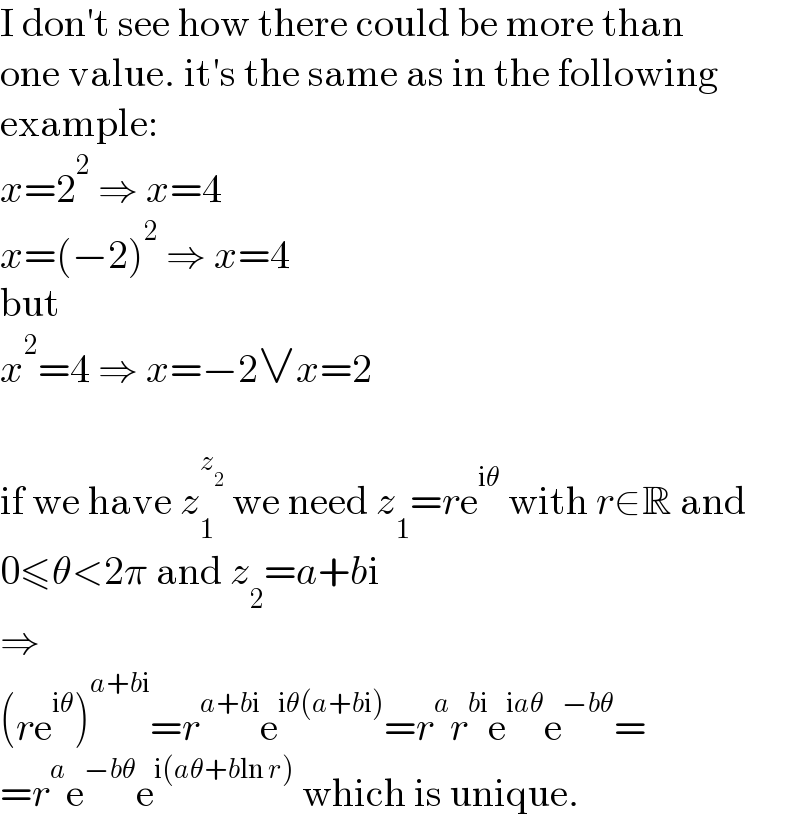Question Number 156186 by DavidSmath last updated on 09/Oct/21

Commented by DavidSmath last updated on 09/Oct/21

$$\mathrm{show}\:\mathrm{clear}\:\mathrm{workings}… \\ $$
Commented by MJS_new last updated on 09/Oct/21

$$\mathrm{I}\:\mathrm{don}'\mathrm{t}\:\mathrm{see}\:\mathrm{how}\:\mathrm{there}\:\mathrm{could}\:\mathrm{be}\:\mathrm{more}\:\mathrm{than} \\ $$$$\mathrm{one}\:\mathrm{value}.\:\mathrm{it}'\mathrm{s}\:\mathrm{the}\:\mathrm{same}\:\mathrm{as}\:\mathrm{in}\:\mathrm{the}\:\mathrm{following} \\ $$$$\mathrm{example}: \\ $$$${x}=\mathrm{2}^{\mathrm{2}} \:\Rightarrow\:{x}=\mathrm{4} \\ $$$${x}=\left(−\mathrm{2}\right)^{\mathrm{2}} \:\Rightarrow\:{x}=\mathrm{4} \\ $$$$\mathrm{but} \\ $$$${x}^{\mathrm{2}} =\mathrm{4}\:\Rightarrow\:{x}=−\mathrm{2}\vee{x}=\mathrm{2} \\ $$$$ \\ $$$$\mathrm{if}\:\mathrm{we}\:\mathrm{have}\:{z}_{\mathrm{1}} ^{{z}_{\mathrm{2}} } \:\mathrm{we}\:\mathrm{need}\:{z}_{\mathrm{1}} ={r}\mathrm{e}^{\mathrm{i}\theta} \:\mathrm{with}\:{r}\in\mathbb{R}\:\mathrm{and} \\ $$$$\mathrm{0}\leqslant\theta<\mathrm{2}\pi\:\mathrm{and}\:{z}_{\mathrm{2}} ={a}+{b}\mathrm{i} \\ $$$$\Rightarrow \\ $$$$\left({r}\mathrm{e}^{\mathrm{i}\theta} \right)^{{a}+{b}\mathrm{i}} ={r}^{{a}+{b}\mathrm{i}} \mathrm{e}^{\mathrm{i}\theta\left({a}+{b}\mathrm{i}\right)} ={r}^{{a}} {r}^{{b}\mathrm{i}} \mathrm{e}^{\mathrm{i}{a}\theta} \mathrm{e}^{−{b}\theta} = \\ $$$$={r}^{{a}} \mathrm{e}^{−{b}\theta} \mathrm{e}^{\mathrm{i}\left({a}\theta+{b}\mathrm{ln}\:{r}\right)} \:\mathrm{which}\:\mathrm{is}\:\mathrm{unique}. \\ $$
Answered by mr W last updated on 09/Oct/21
![z=(2i−1)^(i+1) =[(√5)e^((π−tan^(−1) 2)i) ]^(i+1) =(√5)e^(−π+tan^(−1) 2) [(√5)e^((π−tan^(−1) 2)) ]^i =(√5)e^(−π+tan^(−1) 2) e^((π−tan^(−1) 2+ln (√5))i) it′s principal value is Arg(z)=π−tan^(−1) 2+ln (√5)≈2.839](https://www.tinkutara.com/question/Q156220.png)
$${z}=\left(\mathrm{2}{i}−\mathrm{1}\right)^{{i}+\mathrm{1}} =\left[\sqrt{\mathrm{5}}{e}^{\left(\pi−\mathrm{tan}^{−\mathrm{1}} \mathrm{2}\right){i}} \right]^{{i}+\mathrm{1}} \\ $$$$=\sqrt{\mathrm{5}}{e}^{−\pi+\mathrm{tan}^{−\mathrm{1}} \mathrm{2}} \left[\sqrt{\mathrm{5}}{e}^{\left(\pi−\mathrm{tan}^{−\mathrm{1}} \mathrm{2}\right)} \right]^{{i}} \\ $$$$=\sqrt{\mathrm{5}}{e}^{−\pi+\mathrm{tan}^{−\mathrm{1}} \mathrm{2}} {e}^{\left(\pi−\mathrm{tan}^{−\mathrm{1}} \mathrm{2}+\mathrm{ln}\:\sqrt{\mathrm{5}}\right){i}} \\ $$$${it}'{s}\:{principal}\:{value}\:{is} \\ $$$${Arg}\left({z}\right)=\pi−\mathrm{tan}^{−\mathrm{1}} \mathrm{2}+\mathrm{ln}\:\sqrt{\mathrm{5}}\approx\mathrm{2}.\mathrm{839} \\ $$
